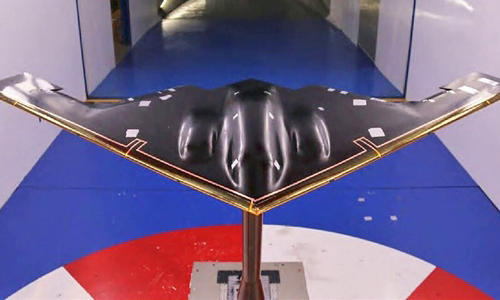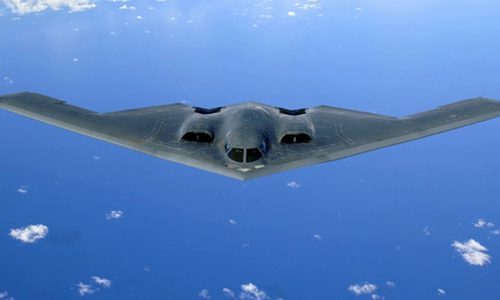The aerodynamic test model of the H-20 bomber resembles the American B-2, causing many to doubt that China copied the design.
The Chinese social network last week spread images of a stealth bomber model tested in a wind tunnel. Some experts believe the picture was taken during the aerodynamic testing of the H-20 stealth bomber design being developed by Beijing.

Experimental model in wind tunnel revealed by China Photo: Drive
The appearance of this model has led many to suspect that China has copied the main form of the US stealth B-2 bomber, similarly accusing it of stealing documents about the US F-35 super fighter. developing J-20 domestic stealth aircraft. "The most obvious thing is that it looks exactly like the B-2 Spirit aircraft," military expert Tyler Rogoway commented.
China Central Television (CCTV) in October 2018 confirmed that the country has completed the development of long-range bombers called H-20 with the design and range of operations similar to the US B-2. H-20 can reach a range of 10,000 km, carry 20 tons of weapons including bombs and cruise missiles with a range of up to 2,000 km, as well as some future weapons such as stealth missiles GB-6A.
The U.S. Defense Intelligence Agency (DIA) said it was just one of two stealth bombers projects pursued by China, of which the H-20 version was responsible for strategic attacks and the JH-XX model. Perform tactical strikes.
"The H-20 project shows that the Chinese aviation industry is making great strides. The H-20 design is completely different from the H-6 bomber developed from the Soviet Tu-16 model. Thanh The H-20 program will help China become the second country in the world to possess stealth bomber technology, "said Rogoway.
However, this may not be the actual design of the H-20, but rather a model of the B-2 Spirit itself. Assessing the basic aerodynamic features on American aircraft will help China complete projects like the H-20 itself.

US Air Force B-2 stealth bomber Photo: USAF
"Ensuring the ability to control large aircraft such as the B-2 in many different operating conditions is a very difficult problem to solve. China invests a lot of resources in unmanned aircraft (UAVs) using design. flying-wing wings, but they will certainly have a series of challenges when they want to enlarge the platform into a manned bomber, "Rogoway said.
Testing of the B-2 model is not only supported for the H-20 project, it can also complement China's aviation knowledge base for future aircraft programs. Chinese engineers can also learn the parameters of radar wave reflection on US stealth bombers, in order to support the development of B-2 air defense systems.
"The appearance of this model does not mean that the completed H-20 model will be identical to the B-2. Copying the shape of the Spirit line is an unusual solution, even for China. They can improve stealth capabilities, high altitude flying capabilities and simplified aircraft design by not using the jagged tail fringes of US bombers, "says Rogoway.
The US military has spent a lot of money editing the B-2 line because of fears Russia has a radar that can deal with stealth aircraft. They require the B-2 to be able to fly low under radar, in addition to high altitude. To meet this requirement, designers had to revise the fuselage frame, reducing the ceiling from 18 km to under 15 km. The B-2 mass also increased significantly, resulting in a reduced flight range and team-building costs compared to planned.
"China can duplicate the B-2 line, but the image in the wind tunnel is not enough to prove it. It just shows that Beijing is actively studying the design of stealth wings and stealth bombers. Such photos may appear yesterday, but it does not exclude the possibility that they were taken many years ago, "Rogoway said.



 MARBHY
MARBHY







